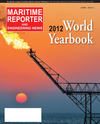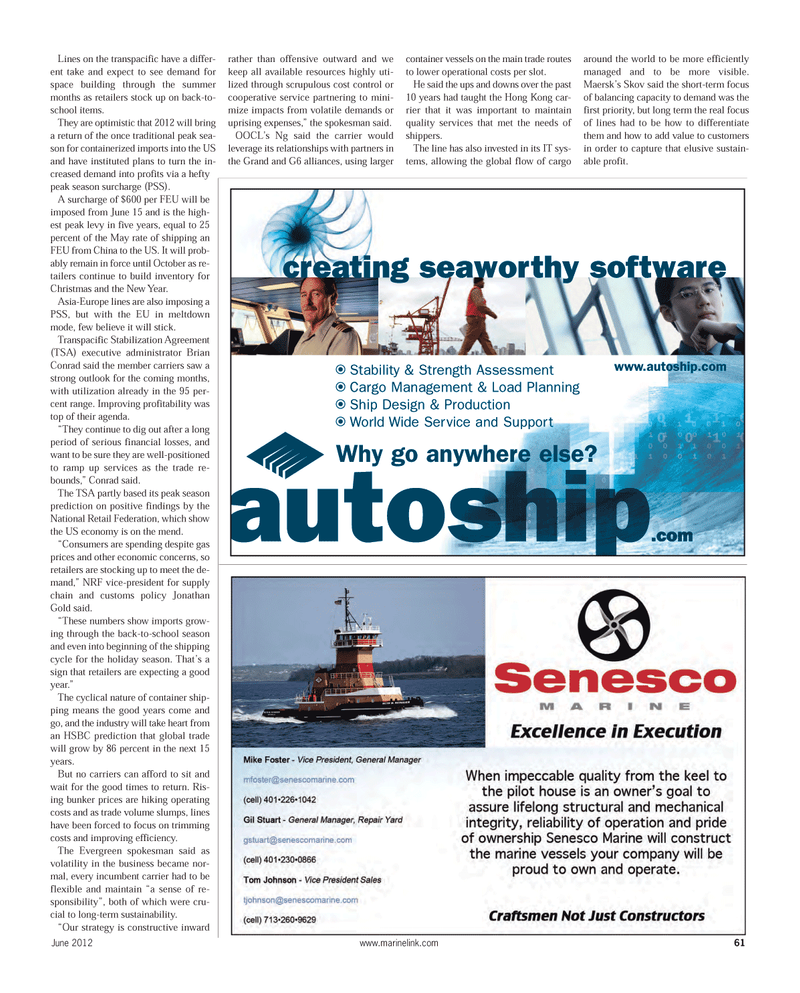
Page 61: of Maritime Reporter Magazine (June 2012)
Annual World Yearbook
Read this page in Pdf, Flash or Html5 edition of June 2012 Maritime Reporter Magazine
Lines on the transpacific have a differ- ent take and expect to see demand for space building through the summer months as retailers stock up on back-to-school items. They are optimistic that 2012 will bring a return of the once traditional peak sea-son for containerized imports into the USand have instituted plans to turn the in- creased demand into profits via a hefty peak season surcharge (PSS). A surcharge of $600 per FEU will be imposed from June 15 and is the high-est peak levy in five years, equal to 25 percent of the May rate of shipping anFEU from China to the US. It will prob-ably remain in force until October as re-tailers continue to build inventory for Christmas and the New Year. Asia-Europe lines are also imposing aPSS, but with the EU in meltdown mode, few believe it will stick. Transpacific Stabilization Agreement (TSA) executive administrator Brian Conrad said the member carriers saw a strong outlook for the coming months,with utilization already in the 95 per- cent range. Improving profitability was top of their agenda.?They continue to dig out after a long period of serious financial losses, and want to be sure they are well-positioned to ramp up services as the trade re-bounds,? Conrad said. The TSA partly based its peak season prediction on positive findings by the National Retail Federation, which show the US economy is on the mend.?Consumers are spending despite gas prices and other economic concerns, soretailers are stocking up to meet the de-mand,? NRF vice-president for supply chain and customs policy Jonathan Gold said. ?These numbers show imports grow- ing through the back-to-school seasonand even into beginning of the shipping cycle for the holiday season. That?s a sign that retailers are expecting a good year.? The cyclical nature of container ship- ping means the good years come andgo, and the industry will take heart from an HSBC prediction that global tradewill grow by 86 percent in the next 15 years.But no carriers can afford to sit and wait for the good times to return. Ris- ing bunker prices are hiking operating costs and as trade volume slumps, lines have been forced to focus on trimming costs and improving efficiency. The Evergreen spokesman said as volatility in the business became nor- mal, every incumbent carrier had to be flexible and maintain ?a sense of re- sponsibility?, both of which were cru-cial to long-term sustainability. ?Our strategy is constructive inward rather than offensive outward and we keep all available resources highly uti- lized through scrupulous cost control orcooperative service partnering to mini- mize impacts from volatile demands or uprising expenses,? the spokesman said. OOCL?s Ng said the carrier would leverage its relationships with partners in the Grand and G6 alliances, using larger container vessels on the main trade routes to lower operational costs per slot. He said the ups and downs over the past 10 years had taught the Hong Kong car- rier that it was important to maintain quality services that met the needs ofshippers.The line has also invested in its IT sys- tems, allowing the global flow of cargo around the world to be more efficiently managed and to be more visible.Maersk?s Skov said the short-term focus of balancing capacity to demand was the first priority, but long term the real focus of lines had to be how to differentiate them and how to add value to customers in order to capture that elusive sustain- able profit. Stability & Strength Assessment Cargo Management & Load Planning Ship Design & Production World Wide Service and Support creating seaworthy software www.autoship.com Why go anywhere else? June 2012www.marinelink.com 61MR June12 # 8 (57-64):MR Template 6/12/2012 9:09 AM Page 61

 60
60

 62
62
